

Compact Muon Solenoid
LHC, CERN
| CMS-HIG-16-041 ; CERN-EP-2017-123 | ||
| Measurements of properties of the Higgs boson decaying into the four-lepton final state in pp collisions at $ \sqrt{s} = $ 13 TeV | ||
| CMS Collaboration | ||
| 30 June 2017 | ||
| JHEP 11 (2017) 047 | ||
| Abstract: Properties of the Higgs boson are measured in the $\mathrm{ H }\to\mathrm{ Z }\mathrm{ Z }\to4\ell$ ($\ell=$ e, $\mu$) decay channel. A data sample of proton-proton collisions at $ \sqrt{s} = $ 13 TeV, collected with the CMS detector at the LHC and corresponding to an integrated luminosity of 35.9 fb$^{-1}$ is used. The signal strength modifier $\mu$, defined as the ratio of the observed Higgs boson rate in the $\mathrm{ H }\to\mathrm{ Z }\mathrm{ Z }\to4\ell$ decay channel to the standard model expectation, is measured to be $\mu= $ 1.05$^{+0.19}_{-0.17}$ at $m_{\mathrm{ H }}= $ 125.09 GeV, the combined ATLAS and CMS measurement of the Higgs boson mass. The signal strength modifiers for the individual Higgs boson production modes are also measured. The cross section in the fiducial phase space defined by the requirements on lepton kinematics and event topology is measured to be 2.92$ ^{+0.48}_{-0.44} $ (stat)$ ^{+0.28}_{-0.24}$ (syst) fb, which is compatible with the standard model prediction of 2.76 $\pm$ 014 fb. Differential cross sections are reported as a function of the transverse momentum of the Higgs boson, the number of associated jets, and the transverse momentum of the leading associated jet. The Higgs boson mass is measured to be $m_{\mathrm{ H }}= $ 125.26 $\pm$ 0.21 GeV and the width is constrained using on-shell production to be $\Gamma_{\mathrm{ H } } < $ 1.10 GeV, at 95% confidence level. | ||
| Links: e-print arXiv:1706.09936 [hep-ex] (PDF) ; CDS record ; inSPIRE record ; HepData record ; CADI line (restricted) ; | ||
| Figures & Tables | Summary | Additional Figures | References | CMS Publications |
|---|
| Figures | |

png pdf |
Figure 1:
Relative signal purity in the seven event categories in terms of the five main production mechanisms of the Higgs boson in the 118 $ < {m_{4\ell }} < $ 130 GeV mass window are shown. The WH, ZH, and $ {{\mathrm{ t } {}\mathrm{ \bar{t} } } \mathrm{ H } } $ processes are split according to the decay of the associated particles, where X denotes anything other than an electron or muon. Numbers indicate the total expected signal event yields in each category. |

png pdf |
Figure 2:
Difference between the ${\mathrm{ Z } } \to \ell \ell $ mass peak positions in data (${m}^\text {peak}_\text {data}$) and simulation (${m}^\text {peak}_\mathrm {MC}$) normalized by the nominal Z boson mass (${m}_{\mathrm{ Z } } $), as a function of the $ {p_{\mathrm {T}}} $ and $ {| \eta | }$ of one of the leptons regardless of the second for electrons (left) and muons (right). |

png pdf |
Figure 2-a:
Difference between the ${\mathrm{ Z } } \to \ell \ell $ mass peak positions in data (${m}^\text {peak}_\text {data}$) and simulation (${m}^\text {peak}_\mathrm {MC}$) normalized by the nominal Z boson mass (${m}_{\mathrm{ Z } } $), as a function of the $ {p_{\mathrm {T}}} $ and $ {| \eta | }$ of one of the leptons regardless of the second for electrons. |

png pdf |
Figure 2-b:
Difference between the ${\mathrm{ Z } } \to \ell \ell $ mass peak positions in data (${m}^\text {peak}_\text {data}$) and simulation (${m}^\text {peak}_\mathrm {MC}$) normalized by the nominal Z boson mass (${m}_{\mathrm{ Z } } $), as a function of the $ {p_{\mathrm {T}}} $ and $ {| \eta | }$ of one of the leptons regardless of the second for muons. |
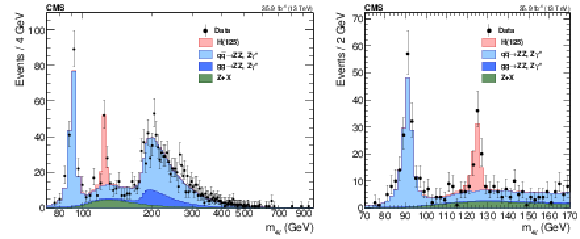
png pdf |
Figure 3:
Distribution of the reconstructed four-lepton invariant mass $ {m_{4\ell }} $ in the full mass range (left) and the low-mass range (right). Points with error bars represent the data and stacked histograms represent expected signal and background distributions. The SM Higgs boson signal with $ {m_{\mathrm{ H } }} = $ 125 GeV, denoted as H(125), and the ZZ backgrounds are normalized to the SM expectation, whilst the Z+X background is normalized to the estimation from data. The order in perturbation theory used for the normalization of the irreducible backgrounds is described in Section 7.1. No events are observed with $ {m_{4\ell }} > $ 1 TeV. |
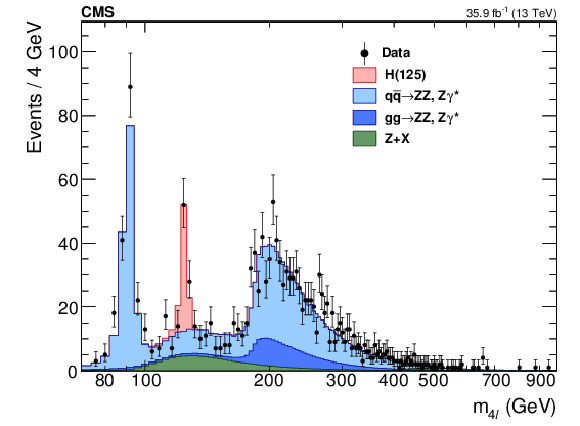
png pdf |
Figure 3-a:
Distribution of the reconstructed four-lepton invariant mass $ {m_{4\ell }} $ in the full mass range. Points with error bars represent the data and stacked histograms represent expected signal and background distributions. The SM Higgs boson signal with $ {m_{\mathrm{ H } }} = $ 125 GeV, denoted as H(125), and the ZZ backgrounds are normalized to the SM expectation, whilst the Z+X background is normalized to the estimation from data. The order in perturbation theory used for the normalization of the irreducible backgrounds is described in Section 7.1. No events are observed with $ {m_{4\ell }} > $ 1 TeV. |

png pdf |
Figure 3-b:
Distribution of the reconstructed four-lepton invariant mass $ {m_{4\ell }} $ in the low-mass range. Points with error bars represent the data and stacked histograms represent expected signal and background distributions. The SM Higgs boson signal with $ {m_{\mathrm{ H } }} = $ 125 GeV, denoted as H(125), and the ZZ backgrounds are normalized to the SM expectation, whilst the Z+X background is normalized to the estimation from data. The order in perturbation theory used for the normalization of the irreducible backgrounds is described in Section 7.1. |

png pdf |
Figure 4:
Distribution of the reconstructed four-lepton invariant mass in the seven event categories for the low-mass range. (Top left) untagged category. (Top right) VBF-1jet-tagged category. (Center left) VBF-2jet-tagged category. (Center right) VH-hadronic-tagged category. (Bottom left) VH-leptonic-tagged category. (Bottom middle) VH-E$_T^\text {miss}$-tagged category. (Bottom right) ${{\mathrm{ t } {}\mathrm{ \bar{t} } } \mathrm{ H } } $-tagged category. Points with error bars represent the data and stacked histograms represent expected signal and background distributions. The SM Higgs boson signal with $ {m_{\mathrm{ H } }} = $ 125 GeV, denoted as H(125), and the ZZ backgrounds are normalized to the SM expectation, whilst the Z+X background is normalized to the estimation from data. For the categories other than the untagged category, the SM Higgs boson signal is separated into two components: the production mode that is targeted by the specific category, and other production modes, where the gluon fusion dominates. The order in perturbation theory used for the normalization of the irreducible backgrounds is described in Section 7.1. |

png pdf |
Figure 4-a:
Distribution of the reconstructed four-lepton invariant mass in the untagged event category for the low-mass range.Points with error bars represent the data and stacked histograms represent expected signal and background distributions. The SM Higgs boson signal with $ {m_{\mathrm{ H } }} = $ 125 GeV, denoted as H(125), and the ZZ backgrounds are normalized to the SM expectation, whilst the Z+X background is normalized to the estimation from data. The order in perturbation theory used for the normalization of the irreducible backgrounds is described in Section 7.1. |
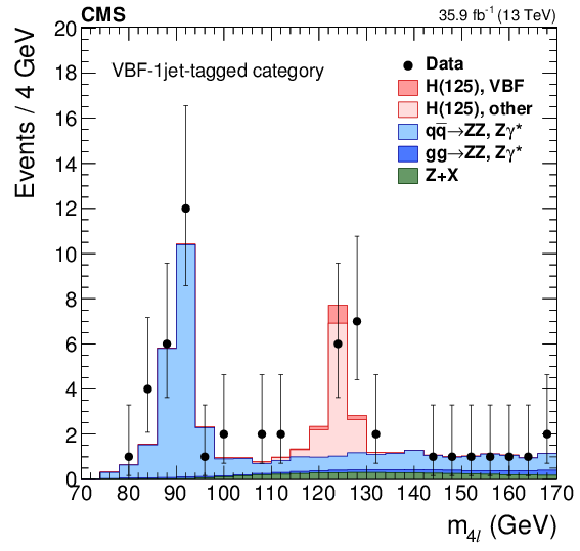
png pdf |
Figure 4-b:
Distribution of the reconstructed four-lepton invariant mass in the VBF-1jet-tagged event category for the low-mass range.Points with error bars represent the data and stacked histograms represent expected signal and background distributions. The SM Higgs boson signal with $ {m_{\mathrm{ H } }} = $ 125 GeV, denoted as H(125), and the ZZ backgrounds are normalized to the SM expectation, whilst the Z+X background is normalized to the estimation from data. The SM Higgs boson signal is separated into two components: the production mode that is targeted by the specific category, and other production modes, where the gluon fusion dominates. The order in perturbation theory used for the normalization of the irreducible backgrounds is described in Section 7.1. |
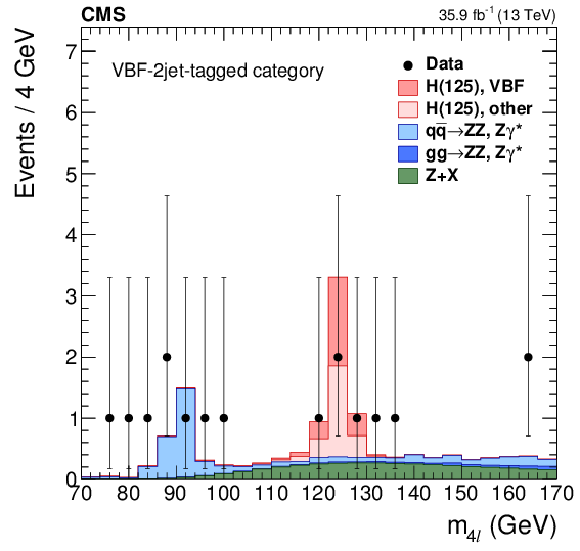
png pdf |
Figure 4-c:
Distribution of the reconstructed four-lepton invariant mass in the VBF-2jet-tagged event category for the low-mass range.Points with error bars represent the data and stacked histograms represent expected signal and background distributions. The SM Higgs boson signal with $ {m_{\mathrm{ H } }} = $ 125 GeV, denoted as H(125), and the ZZ backgrounds are normalized to the SM expectation, whilst the Z+X background is normalized to the estimation from data. The SM Higgs boson signal is separated into two components: the production mode that is targeted by the specific category, and other production modes, where the gluon fusion dominates. The order in perturbation theory used for the normalization of the irreducible backgrounds is described in Section 7.1. |
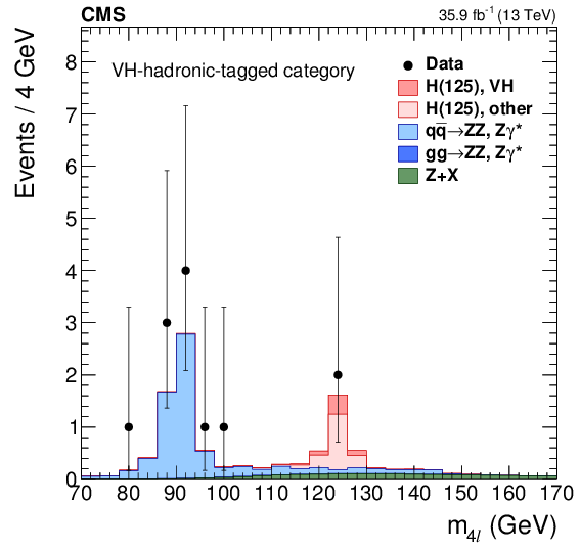
png pdf |
Figure 4-d:
Distribution of the reconstructed four-lepton invariant mass in the VH-hadronic-tagged event category for the low-mass range.Points with error bars represent the data and stacked histograms represent expected signal and background distributions. The SM Higgs boson signal with $ {m_{\mathrm{ H } }} = $ 125 GeV, denoted as H(125), and the ZZ backgrounds are normalized to the SM expectation, whilst the Z+X background is normalized to the estimation from data. The SM Higgs boson signal is separated into two components: the production mode that is targeted by the specific category, and other production modes, where the gluon fusion dominates. The order in perturbation theory used for the normalization of the irreducible backgrounds is described in Section 7.1. |
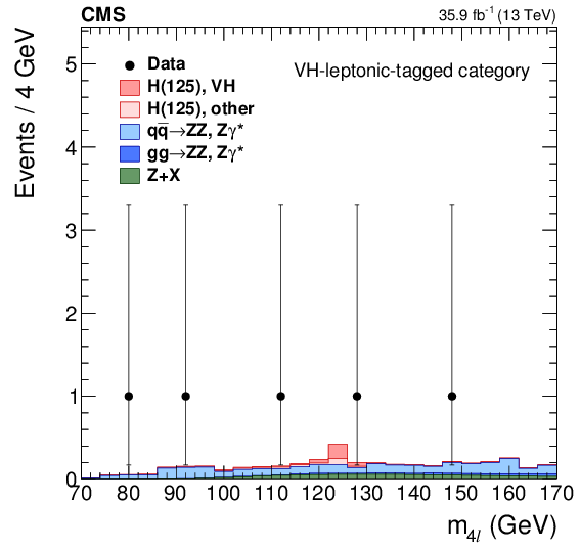
png pdf |
Figure 4-e:
Distribution of the reconstructed four-lepton invariant mass in the VH-leptonic-tagged event category for the low-mass range.Points with error bars represent the data and stacked histograms represent expected signal and background distributions. The SM Higgs boson signal with $ {m_{\mathrm{ H } }} = $ 125 GeV, denoted as H(125), and the ZZ backgrounds are normalized to the SM expectation, whilst the Z+X background is normalized to the estimation from data. The SM Higgs boson signal is separated into two components: the production mode that is targeted by the specific category, and other production modes, where the gluon fusion dominates. The order in perturbation theory used for the normalization of the irreducible backgrounds is described in Section 7.1. |

png pdf |
Figure 4-f:
Distribution of the reconstructed four-lepton invariant mass in the VH-E$_T^\text {miss}$-tagged event category for the low-mass range.Points with error bars represent the data and stacked histograms represent expected signal and background distributions. The SM Higgs boson signal with $ {m_{\mathrm{ H } }} = $ 125 GeV, denoted as H(125), and the ZZ backgrounds are normalized to the SM expectation, whilst the Z+X background is normalized to the estimation from data. The SM Higgs boson signal is separated into two components: the production mode that is targeted by the specific category, and other production modes, where the gluon fusion dominates. The order in perturbation theory used for the normalization of the irreducible backgrounds is described in Section 7.1. |

png pdf |
Figure 4-g:
Distribution of the reconstructed four-lepton invariant mass in the ${{\mathrm{ t } {}\mathrm{ \bar{t} } } \mathrm{ H } } $-tagged event category for the low-mass range.Points with error bars represent the data and stacked histograms represent expected signal and background distributions. The SM Higgs boson signal with $ {m_{\mathrm{ H } }} = $ 125 GeV, denoted as H(125), and the ZZ backgrounds are normalized to the SM expectation, whilst the Z+X background is normalized to the estimation from data. The SM Higgs boson signal is separated into two components: the production mode that is targeted by the specific category, and other production modes, where the gluon fusion dominates. The order in perturbation theory used for the normalization of the irreducible backgrounds is described in Section 7.1. |

png pdf |
Figure 5:
Distribution of the $\mathrm{ Z } _1$ (left) and $\mathrm{ Z } _2$ (middle) reconstructed invariant masses and two-dimensional distribution of these two variables (right) in the mass region 118 $ < {m_{4\ell }} < $ 130 GeV. The stacked histograms and the gray scale represent the expected signal and background distributions, and points represent the data. The SM Higgs boson signal with $ {m_{\mathrm{ H } }} = $ 125 GeV, denoted as H(125), and the ZZ backgrounds are normalized to the SM expectation, whilst the Z+X background is normalized to the estimation from data. The order in perturbation theory used for the normalization of the irreducible backgrounds is described in Section 7.1. |

png pdf |
Figure 5-a:
Distribution of the $\mathrm{ Z } _1$ reconstructed invariant mass in the mass region 118 $ < {m_{4\ell }} < $ 130 GeV. The stacked histograms and the gray scale represent the expected signal and background distributions, and points represent the data. The SM Higgs boson signal with $ {m_{\mathrm{ H } }} = $ 125 GeV, denoted as H(125), and the ZZ backgrounds are normalized to the SM expectation, whilst the Z+X background is normalized to the estimation from data. The order in perturbation theory used for the normalization of the irreducible backgrounds is described in Section 7.1. |

png pdf |
Figure 5-b:
Distribution of the $\mathrm{ Z } _2$ reconstructed invariant mass in the mass region 118 $ < {m_{4\ell }} < $ 130 GeV. The stacked histograms and the gray scale represent the expected signal and background distributions, and points represent the data. The SM Higgs boson signal with $ {m_{\mathrm{ H } }} = $ 125 GeV, denoted as H(125), and the ZZ backgrounds are normalized to the SM expectation, whilst the Z+X background is normalized to the estimation from data. The order in perturbation theory used for the normalization of the irreducible backgrounds is described in Section 7.1. |
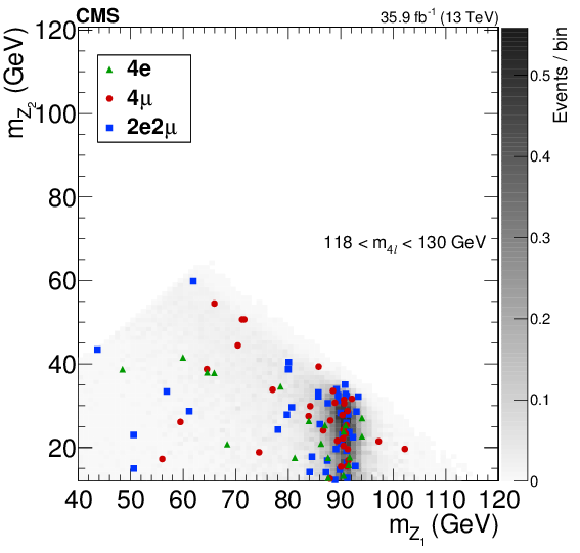
png pdf |
Figure 5-c:
Two-dimensional distribution of the $\mathrm{ Z } _1$ and $\mathrm{ Z } _2$ reconstructed invariant masses in the mass region 118 $ < {m_{4\ell }} < $ 130 GeV. The stacked histograms and the gray scale represent the expected signal and background distributions, and points represent the data. The SM Higgs boson signal with $ {m_{\mathrm{ H } }} = $ 125 GeV, denoted as H(125), and the ZZ backgrounds are normalized to the SM expectation, whilst the Z+X background is normalized to the estimation from data. The order in perturbation theory used for the normalization of the irreducible backgrounds is described in Section 7.1. |
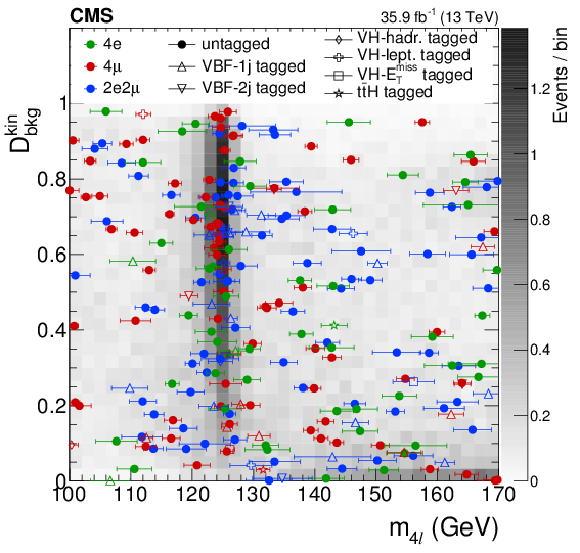
png pdf |
Figure 6:
Distribution of $ {\mathcal {D}^\text {kin}_\text {bkg}} $ versus $ {m_{4\ell }} $ in the mass region 100 $ < {m_{4\ell }} < $ 170 GeV. The gray scale represents the expected total number of ZZ background and SM Higgs boson signal events for $ {m_{\mathrm{ H } }} = $ 125 GeV. The points show the data and the horizontal bars represent $\mathrm {\mathcal {D}_\text {mass}} $. Different marker colors and styles are used to denote final state and the categorization of the events, respectively. |

png pdf |
Figure 7:
Distribution of categorization discriminants in the mass region 118 $ < {m_{4\ell }} < $ 130 GeV. (Left) ${\mathcal {D}_\text {2 jet}} $. (Middle) ${\mathcal {D}_\text {1 jet}} $. (Right) ${\mathcal {D}_{\mathrm {V}\mathrm{ H } }} = max( {\mathcal {D}_{ {\mathrm{ W } \mathrm{ H } } }} $, ${\mathcal {D}_{ {\mathrm{ Z } \mathrm{ H } } }} )$. Points with error bars represent the data and stacked histograms represent expected signal and background distributions. The SM Higgs boson signal with $ {m_{\mathrm{ H } }} = $ 125 GeV, denoted as H(125), and the ZZ backgrounds are normalized to the SM expectation, whilst the Z+X background is normalized to the estimation from data. The vertical gray dashed lines denote the working points used in the event categorization. The SM Higgs boson signal is separated into two components: the production mode that is targeted by the specific discriminant, and other production modes, where the gluon fusion dominates. The order in perturbation theory used for the normalization of the irreducible backgrounds is described in Section 7.1. |

png pdf |
Figure 7-a:
Distribution of the ${\mathcal {D}_\text {2 jet}} $ categorization discriminant in the mass region 118 $ < {m_{4\ell }} < $ 130 GeV. Points with error bars represent the data and stacked histograms represent expected signal and background distributions. The SM Higgs boson signal with $ {m_{\mathrm{ H } }} = $ 125 GeV, denoted as H(125), and the ZZ backgrounds are normalized to the SM expectation, whilst the Z+X background is normalized to the estimation from data. The vertical gray dashed lines denote the working points used in the event categorization. The SM Higgs boson signal is separated into two components: the production mode that is targeted by the specific discriminant, and other production modes, where the gluon fusion dominates. The order in perturbation theory used for the normalization of the irreducible backgrounds is described in Section 7.1. |
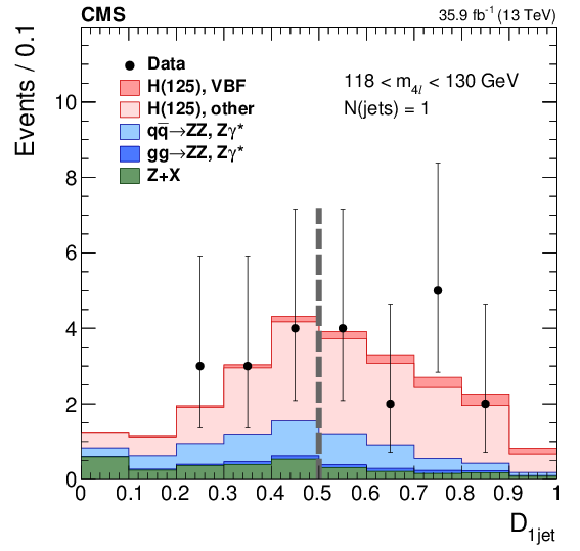
png pdf |
Figure 7-b:
Distribution of the ${\mathcal {D}_\text {1 jet}} $ categorization discriminant in the mass region 118 $ < {m_{4\ell }} < $ 130 GeV. Points with error bars represent the data and stacked histograms represent expected signal and background distributions. The SM Higgs boson signal with $ {m_{\mathrm{ H } }} = $ 125 GeV, denoted as H(125), and the ZZ backgrounds are normalized to the SM expectation, whilst the Z+X background is normalized to the estimation from data. The vertical gray dashed lines denote the working points used in the event categorization. The SM Higgs boson signal is separated into two components: the production mode that is targeted by the specific discriminant, and other production modes, where the gluon fusion dominates. The order in perturbation theory used for the normalization of the irreducible backgrounds is described in Section 7.1. |

png pdf |
Figure 7-c:
Distribution of the ${\mathcal {D}_{\mathrm {V}\mathrm{ H } }} = max( {\mathcal {D}_{ {\mathrm{ W } \mathrm{ H } } }} $, ${\mathcal {D}_{ {\mathrm{ Z } \mathrm{ H } } }} )$ categorization discriminant in the mass region 118 $ < {m_{4\ell }} < $ 130 GeV. Points with error bars represent the data and stacked histograms represent expected signal and background distributions. The SM Higgs boson signal with $ {m_{\mathrm{ H } }} = $ 125 GeV, denoted as H(125), and the ZZ backgrounds are normalized to the SM expectation, whilst the Z+X background is normalized to the estimation from data. The vertical gray dashed lines denote the working points used in the event categorization. The SM Higgs boson signal is separated into two components: the production mode that is targeted by the specific discriminant, and other production modes, where the gluon fusion dominates. The order in perturbation theory used for the normalization of the irreducible backgrounds is described in Section 7.1. |
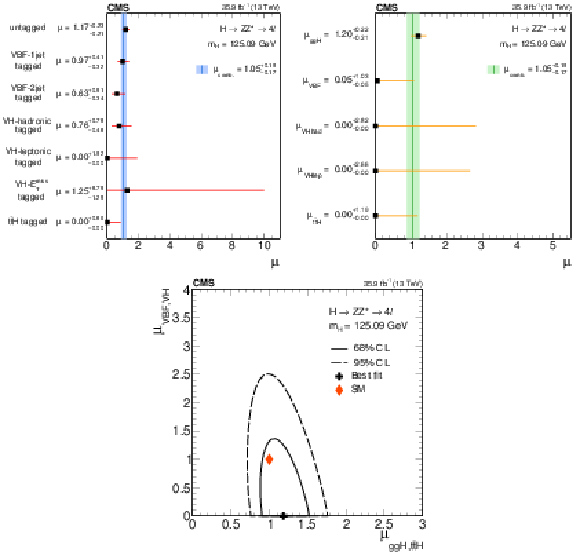
png pdf |
Figure 8:
(Top left) Observed values of the signal strength modifier $\mu =\sigma /\sigma _{SM}$ for the seven event categories, compared to the combined $\mu $ shown as a vertical line. The horizontal bars and the filled band indicate the $\pm $1$\sigma $ uncertainties. (Top right) Results of likelihood scans for the signal strength modifiers corresponding to the main SM Higgs boson production modes, compared to the combined $\mu $ shown as a vertical line. The horizontal bars and the filled band indicate the $\pm $1$\sigma $ uncertainties. The uncertainties include both statistical and systematic sources. (Bottom) Result of the 2D likelihood scan for the $ {\mu _{\mathrm{g} \mathrm{g} \mathrm{ H }, {\mathrm{ t } {}\mathrm{ \bar{t} } } \mathrm{ H } }} $ and $ {\mu _{\mathrm {VBF},\mathrm {V\mathrm{ H } }}} $ signal strength modifiers. The solid and dashed contours show the 68% and 95% CL regions, respectively. The cross indicates the best fit values, and the diamond represents the expected values for the SM Higgs boson. |

png pdf |
Figure 8-a:
Observed values of the signal strength modifier $\mu =\sigma /\sigma _{SM}$ for the seven event categories, compared to the combined $\mu $ shown as a vertical line. The horizontal bars and the filled band indicate the $\pm $1$\sigma $ uncertainties. |

png pdf |
Figure 8-b:
Results of likelihood scans for the signal strength modifiers corresponding to the main SM Higgs boson production modes, compared to the combined $\mu $ shown as a vertical line. The horizontal bars and the filled band indicate the $\pm $1$\sigma $ uncertainties. The uncertainties include both statistical and systematic sources. |

png pdf |
Figure 8-c:
Result of the 2D likelihood scan for the $ {\mu _{\mathrm{g} \mathrm{g} \mathrm{ H }, {\mathrm{ t } {}\mathrm{ \bar{t} } } \mathrm{ H } }} $ and $ {\mu _{\mathrm {VBF},\mathrm {V\mathrm{ H } }}} $ signal strength modifiers. The solid and dashed contours show the 68% and 95% CL regions, respectively. The cross indicates the best fit values, and the diamond represents the expected values for the SM Higgs boson. |
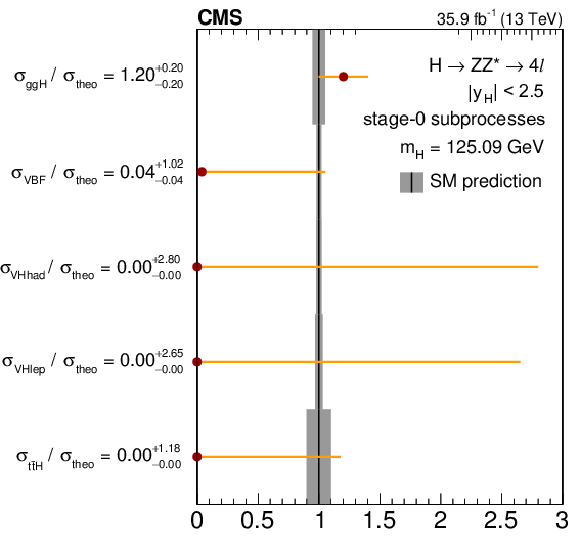
png pdf |
Figure 9:
Results of the fit for simplified template cross sections for the 'stage-0 subprocesses', normalized to the SM predictions. The grey bands indicate the theoretical uncertainties in the SM predictions. The orange error bars show the full uncertainty, including experimental uncertainties and theoretical uncertainties causing migration of events between the various categories. See Ref. [34] for further details of this approach. |

png pdf |
Figure 10:
The measured fiducial cross section as a function of $\sqrt {s}$ (top left). The acceptance is calculated using NNLOPS at $\sqrt {s} = $ 13 TeV and HRES [40,39] at $\sqrt {s} = $ 7 and 8 TeV and the total cross sections and uncertainties are taken from Ref. [34]. The fiducial volume for $\sqrt {s} = $ 7 and 8 TeV uses the lepton isolation definition from Ref. [22], while for $\sqrt {s} = $ 13 TeV the definition described in the text is used. The results of the differential cross section measurements are shown for $ {p_{\mathrm {T}}} (\mathrm{ H } )$ (top right), N(jets) (bottom left) and $ {p_{\mathrm {T}}} (\text {jet})$ of the leading associated jet (bottom right). The acceptance and theoretical uncertainties in the differential bins are calculated using POWHEG and NNLOPS. The subdominant component of the signal ($\mathrm {VBF} + \mathrm {V}\mathrm{ H } + {{\mathrm{ t } {}\mathrm{ \bar{t} } } \mathrm{ H } } $) is denoted as XH. In the differential cross section measurement for $ {p_{\mathrm {T}}} (\mathrm{ H } )$, the last bin represents the integrated cross section for $ {p_{\mathrm {T}}} (\mathrm{ H } ) > $ 200 GeV and is scaled by 1/50 for presentation purposes. No events are observed with $ {p_{\mathrm {T}}} (\mathrm{ H } ) > $ 200 GeV. |

png pdf |
Figure 10-a:
The measured fiducial cross section as a function of $\sqrt {s}$. The acceptance is calculated using NNLOPS at $\sqrt {s} = $ 13 TeV and HRES [40,39] at $\sqrt {s} = $ 7 and 8 TeV and the total cross sections and uncertainties are taken from Ref. [34]. The fiducial volume for $\sqrt {s} = $ 7 and 8 TeV uses the lepton isolation definition from Ref. [22], while for $\sqrt {s} = $ 13 TeV the definition described in the text is used. |
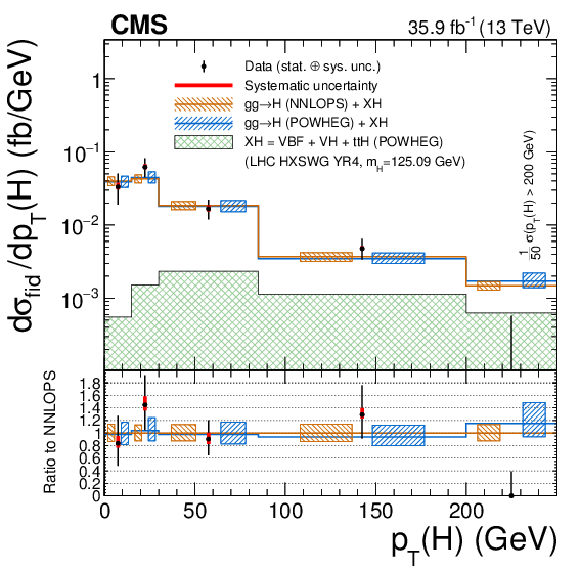
png pdf |
Figure 10-b:
The results of the differential cross section measurements are shown for $ {p_{\mathrm {T}}} (\mathrm{ H } )$. The acceptance and theoretical uncertainties in the differential bins are calculated using POWHEG and NNLOPS. The subdominant component of the signal ($\mathrm {VBF} + \mathrm {V}\mathrm{ H } + {{\mathrm{ t } {}\mathrm{ \bar{t} } } \mathrm{ H } } $) is denoted as XH. In the differential cross section measurement for $ {p_{\mathrm {T}}} (\mathrm{ H } )$, the last bin represents the integrated cross section for $ {p_{\mathrm {T}}} (\mathrm{ H } ) > $ 200 GeV and is scaled by 1/50 for presentation purposes. No events are observed with $ {p_{\mathrm {T}}} (\mathrm{ H } ) > $ 200 GeV. |

png pdf |
Figure 10-c:
The results of the differential cross section measurements are shown for N(jets). The acceptance and theoretical uncertainties in the differential bins are calculated using POWHEG and NNLOPS. The subdominant component of the signal ($\mathrm {VBF} + \mathrm {V}\mathrm{ H } + {{\mathrm{ t } {}\mathrm{ \bar{t} } } \mathrm{ H } } $) is denoted as XH. In the differential cross section measurement for $ {p_{\mathrm {T}}} (\mathrm{ H } )$, the last bin represents the integrated cross section for $ {p_{\mathrm {T}}} (\mathrm{ H } ) > $ 200 GeV and is scaled by 1/50 for presentation purposes. No events are observed with $ {p_{\mathrm {T}}} (\mathrm{ H } ) > $ 200 GeV. |

png pdf |
Figure 10-d:
The results of the differential cross section measurements are shown for $ {p_{\mathrm {T}}} (\text {jet})$ of the leading associated jet. The acceptance and theoretical uncertainties in the differential bins are calculated using POWHEG and NNLOPS. The subdominant component of the signal ($\mathrm {VBF} + \mathrm {V}\mathrm{ H } + {{\mathrm{ t } {}\mathrm{ \bar{t} } } \mathrm{ H } } $) is denoted as XH. In the differential cross section measurement for $ {p_{\mathrm {T}}} (\mathrm{ H } )$, the last bin represents the integrated cross section for $ {p_{\mathrm {T}}} (\mathrm{ H } ) > $ 200 GeV and is scaled by 1/50 for presentation purposes. No events are observed with $ {p_{\mathrm {T}}} (\mathrm{ H } ) > $ 200 GeV. |
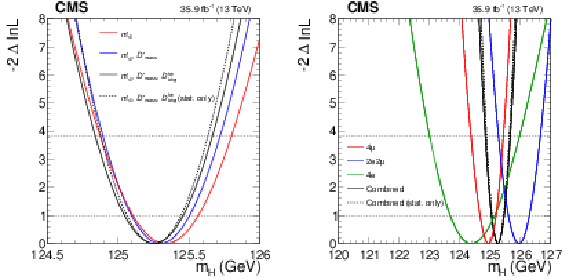
png pdf |
Figure 11:
Left: 1D likelihood scans as a function of the Higgs boson mass for the 1D, 2D, and 3D measurement. Right: 1D likelihood scans as a function of mass for the different final states and the combination of all final states for the 3D mass measurement. The likelihood scans are shown for the mass measurement using the refitted mass distribution with the $m(\mathrm{ Z } _1)$ constraint. Solid lines represent scans with all uncertainties included, dashed lines those with only statistical uncertainties. |

png pdf |
Figure 11-a:
1D likelihood scans as a function of the Higgs boson mass for the 1D, 2D, and 3D measurement. The likelihood scans are shown for the mass measurement using the refitted mass distribution with the $m(\mathrm{ Z } _1)$ constraint. Solid lines represent scans with all uncertainties included, dashed lines those with only statistical uncertainties. |

png pdf |
Figure 11-b:
1D likelihood scans as a function of mass for the different final states and the combination of all final states for the 3D mass measurement. The likelihood scans are shown for the mass measurement using the refitted mass distribution with the $m(\mathrm{ Z } _1)$ constraint. Solid lines represent scans with all uncertainties included, dashed lines those with only statistical uncertainties. |

png pdf |
Figure 12:
(Left) Observed likelihood scan of $m_\mathrm{ H } $ and $\Gamma _\mathrm{ H } $ using the signal range 105 $ < m_{4\ell } < $ 140 GeV. (Right) Observed and expected likelihood scan of $\Gamma _\mathrm{ H } $ using the signal range 105 $ < m_{4\ell } < $ 140 GeV, with $m_\mathrm{ H } $ profiled. |

png pdf |
Figure 12-a:
Observed likelihood scan of $m_\mathrm{ H } $ and $\Gamma _\mathrm{ H } $ using the signal range 105 $ < m_{4\ell } < $ 140 GeV. |

png pdf |
Figure 12-b:
Observed and expected likelihood scan of $\Gamma _\mathrm{ H } $ using the signal range 105 $ < m_{4\ell } < $ 140 GeV, with $m_\mathrm{ H } $ profiled. |
| Tables | |
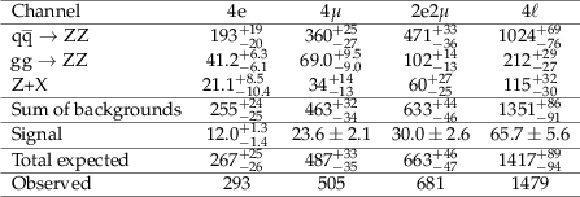
png pdf |
Table 1:
The numbers of expected background and signal events and the number of observed candidate events after the full selection, for each final state, for $ {m_{4\ell }} > $ 70 GeV. The signal and ZZ backgrounds are estimated from simulation, while the Z+X event yield is estimated from data. Uncertainties include statistical and systematic sources. |

png pdf |
Table 2:
The numbers of expected background and signal events and the number of observed candidate events after the full selection, for each event category, for the mass range 118 $ < {m_{4\ell }} < $ 130 GeV. The yields are given for the different production modes. The signal and ZZ backgrounds yields are estimated from simulation, while the Z+X yield is estimated from data. |

png pdf |
Table 3:
Expected and observed signal strength modifiers. |

png pdf |
Table 4:
Summary of requirements and selections used in the definition of the fiducial phase space for the $\mathrm{ p } \mathrm{ p } \to {\mathrm{ H } \to 4\ell } $ cross section measurements. |

png pdf |
Table 5:
Summary of the fraction of signal events for different SM signal production modes within the fiducial phase space (acceptance $\mathcal {A}_\text {fid}$), reconstruction efficiency ($\epsilon $) for signal events from within the fiducial phase space, and ratio of reconstructed events which are from outside the fiducial phase space to reconstructed events which are from within the fiducial phase space ($f_\text {nonfid}$). For all production modes the values given are for $m_\mathrm{ H } = $ 125 GeV. Also shown in the last column is the factor $(1+f_{\text {nonfid}})\epsilon $ which regulates the signal yield for a given fiducial cross section, as shown in Eq. 9. The uncertainties listed are statistical only, and the statistical uncertainty in the acceptance is $\sim $0.001. |

png pdf |
Table 6:
Best fit values for the mass of the Higgs boson measured in the $4\ell $ final states, with the 1D, 2D, and 3D fit, respectively, as described in the text. All mass values are given in GeV. The uncertainties include both the statistical and systematic components. The expected $ {m_{\mathrm{ H } }} $ uncertainty change shows the change in the expected precision on the measurement for the different fit scenarios, relative to 3D $\mathcal {L}(m'_{4\ell }$, $\mathrm {\mathcal {D}'_\text {mass}} $, ${\mathcal {D}^\text {kin}_\text {bkg}} )$. |

png pdf |
Table 7:
Summary of allowed 68%CL (central values with uncertainties) and 95%CL (ranges in square brackets) intervals on the width $\Gamma _\mathrm{ H } $ of the Higgs boson. The expected results are quoted for the SM signal production cross section ($\mu _{\mathrm {VBF},\mathrm {V}\mathrm{ H } }=\mu _{\mathrm{g} \mathrm{g} \mathrm{ H },{\mathrm{ t } {}\mathrm{ \bar{t} } } \mathrm{ H } }=$ 1) and the values of $m_\mathrm{ H } = $ 125 GeV. In the observed results $\mu _{\mathrm {VBF},\mathrm {V}\mathrm{ H } }$ and $\mu _{\mathrm{g} \mathrm{g} \mathrm{ H },{\mathrm{ t } {}\mathrm{ \bar{t} } } \mathrm{ H } }$ are left unconstrained in the fit. |
| Summary |
| The first results on Higgs boson production in the four-lepton final state at $ \sqrt{s} = $ 13 TeV have been presented, using 35.9 fb$^{-1}$ of pp collisions collected by the CMS experiment at the LHC. The signal strength modifier $\mu$, defined as the ratio of the observed Higgs boson rate in the $\mathrm{ H }\to\mathrm{ Z }\mathrm{ Z }\to4\ell$ decay channel to the standard model expectation, is measured to be $\mu = $ 1.05 $^{+0.15}_{-0.14}$ (stat) $^{+0.11}_{-0.09}$ (syst) = 1.05$^{+0.19}_{-0.17}$ at $m_{\mathrm{ H }}= $ 125.09 GeV, the combined ATLAS and CMS measurement of the Higgs boson mass. Two signal strength modifiers associated with the fermion- and vector-boson induced contributions to the expected standard model cross section are measured to be ${\mu_{\mathrm{g}\mathrm{g}\mathrm{ H },\,\mathrm{ t \bar{t} }\mathrm{ H }}} = $ 1.19$^{+0.21}_{-0.20} $ and ${\mu_{\mathrm{VBF},\mathrm{V\mathrm{ H }}}} =$ 0.00$^{+0.81}_{-0.00} $, respectively. The cross section at $ \sqrt{s} = $ 13 TeV in a fiducial phase space defined to match the experimental acceptance in terms of the lepton kinematics and event topology, predicted in the standard model to be 2.76$\pm$0.14 fb, is measured to be 2.92$ ^{+0.48}_{-0.44}$ (stat)$ ^{+0.28}_{-0.24}$ (syst) fb. Differential cross sections are reported as a function of the transverse momentum of the Higgs boson, the number of associated jets, and the transverse momentum of the leading associated jet. The mass is measured to be $m_{\mathrm{ H }}= $ 125.26$\pm$ 0.20 (stat) $\pm$ 0.08 (syst) GeV and the width is constrained to be $\Gamma_{\mathrm{ H } } < $ 1.10 GeV at 95% confidence level. The production and decay properties of the Higgs boson are consistent, within their uncertainties, with the expectations for the standard model Higgs boson. |
| Additional Figures | |

png pdf |
Additional Figure 1:
Distributions of $m_{4\ell}$ in the region 70 $ < m_{4\ell} < $ 170 GeV for the 4e (left), 4$\mu $ (middle) and 2e2$\mu $ (right) final states. The stacked histograms represent the expected signal and background distributions, and points represent the data. The SM Higgs boson signal with $m_{\rm {H}} = $ 125 GeV, denoted as ${\rm H}(125)$, and the ZZ backgrounds are normalized to the SM expectation and the Z+X background to the estimation from data. |
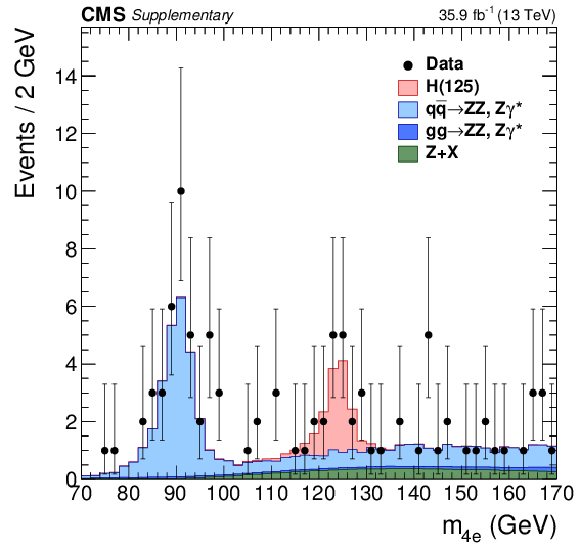
png pdf |
Additional Figure 1-a:
Distribution of $m_{4\ell}$ in the region 70 $ < m_{4\ell} < $ 170 GeV for the 4e final states. The stacked histograms represent the expected signal and background distributions, and points represent the data. The SM Higgs boson signal with $m_{\rm {H}} = $ 125 GeV, denoted as ${\rm H}(125)$, and the ZZ backgrounds are normalized to the SM expectation and the Z+X background to the estimation from data. |

png pdf |
Additional Figure 1-b:
Distribution of $m_{4\ell}$ in the region 70 $ < m_{4\ell} < $ 170 GeV for the 4$\mu$final states. The stacked histograms represent the expected signal and background distributions, and points represent the data. The SM Higgs boson signal with $m_{\rm {H}} = $ 125 GeV, denoted as ${\rm H}(125)$, and the ZZ backgrounds are normalized to the SM expectation and the Z+X background to the estimation from data. |
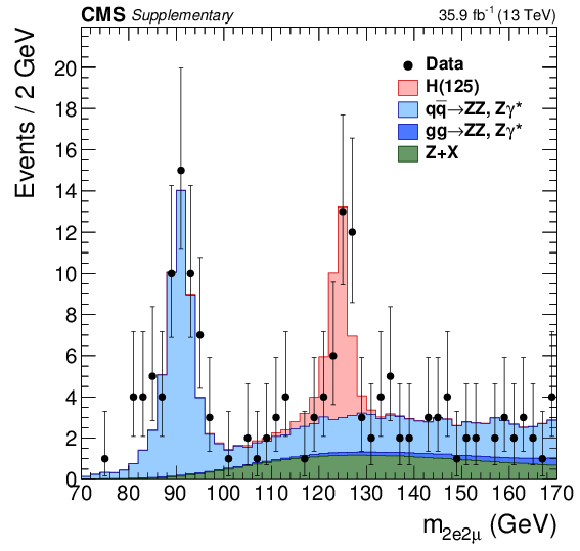
png pdf |
Additional Figure 1-c:
Distribution of $m_{4\ell}$ in the region 70 $ < m_{4\ell} < $ 170 GeV for the 2e2$\mu $ final states. The stacked histograms represent the expected signal and background distributions, and points represent the data. The SM Higgs boson signal with $m_{\rm {H}} = $ 125 GeV, denoted as ${\rm H}(125)$, and the ZZ backgrounds are normalized to the SM expectation and the Z+X background to the estimation from data. |

png pdf |
Additional Figure 2:
Distributions of $m_{4\ell}$ in the region $m_{4\ell} > $ 70 GeV for the 4e (left), 4$\mu $ (middle) and 2e2$\mu $ (right) final states. The stacked histograms represent the expected signal and background distributions, and points represent the data. The SM Higgs boson signal with $m_{\rm {H}} = $ 125 GeV, denoted as ${\rm H}(125)$, and the ZZ backgrounds are normalized to the SM expectation and the Z+X background to the estimation from data. |

png pdf |
Additional Figure 2-a:
Distribution of $m_{4\ell}$ in the region $m_{4\ell} > $ 70 GeV for the 4e final state. The stacked histograms represent the expected signal and background distributions, and points represent the data. The SM Higgs boson signal with $m_{\rm {H}} = $ 125 GeV, denoted as ${\rm H}(125)$, and the ZZ backgrounds are normalized to the SM expectation and the Z+X background to the estimation from data. |
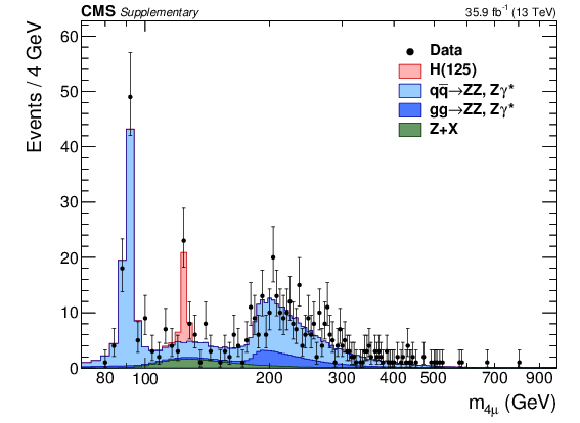
png pdf |
Additional Figure 2-b:
Distribution of $m_{4\ell}$ in the region $m_{4\ell} > $ 70 GeV for the 4$\mu $ final state. The stacked histograms represent the expected signal and background distributions, and points represent the data. The SM Higgs boson signal with $m_{\rm {H}} = $ 125 GeV, denoted as ${\rm H}(125)$, and the ZZ backgrounds are normalized to the SM expectation and the Z+X background to the estimation from data. |

png pdf |
Additional Figure 2-c:
Distribution of $m_{4\ell}$ in the region $m_{4\ell} > $ 70 GeV for the 2e2$\mu $ final state. The stacked histograms represent the expected signal and background distributions, and points represent the data. The SM Higgs boson signal with $m_{\rm {H}} = $ 125 GeV, denoted as ${\rm H}(125)$, and the ZZ backgrounds are normalized to the SM expectation and the Z+X background to the estimation from data. |

png pdf |
Additional Figure 3:
Distribution of $m_{4\ell}$ in the region 70 $ < m_{4\ell} < $ 170 GeV after requiring ${\cal D}^{\rm kin}_{\rm bkg} > $ 0.5. The stacked histograms represent the expected signal and background distributions, and points represent the data. The SM Higgs boson signal with $m_{\rm {H}} = $ 125 GeV, denoted as ${\rm H}(125)$, and the ZZ backgrounds are normalized to the SM expectation and the Z+X background to the estimation from data. |

png pdf |
Additional Figure 4:
Distribution of the $ {\mathrm {Z}}_1$ (a) and $ {\mathrm {Z}}_2$ (b) reconstructed invariant masses in the region $m_{4\ell} > $ 70 GeV. The stacked histograms represent expected signal and background distributions, and points represent the data. The SM Higgs boson signal with $m_{\rm {H}} = $ 125 GeV, denoted as ${\rm H}(125)$, and the ZZ backgrounds are normalized to the SM expectation and the Z+X background to the estimation from data. (c) Correlation between the reconstructed invariant masses $ {\mathrm {Z}}_1$ and $ {\mathrm {Z}}_2$ in the region $m_{4\ell} > $ 70 GeV. The gray scale represents the expected total number of ZZ background and Higgs boson signal events for $m_{\rm H} = $ 125 GeV. |

png pdf |
Additional Figure 4-a:
Distribution of the $ {\mathrm {Z}}_1$ reconstructed invariant mass in the region $m_{4\ell} > $ 70 GeV. The stacked histograms represent expected signal and background distributions, and points represent the data. The SM Higgs boson signal with $m_{\rm {H}} = $ 125 GeV, denoted as ${\rm H}(125)$, and the ZZ backgrounds are normalized to the SM expectation and the Z+X background to the estimation from data. |

png pdf |
Additional Figure 4-b:
Distribution of the $ {\mathrm {Z}}_2$ reconstructed invariant mass in the region $m_{4\ell} > $ 70 GeV. The stacked histograms represent expected signal and background distributions, and points represent the data. The SM Higgs boson signal with $m_{\rm {H}} = $ 125 GeV, denoted as ${\rm H}(125)$, and the ZZ backgrounds are normalized to the SM expectation and the Z+X background to the estimation from data. |
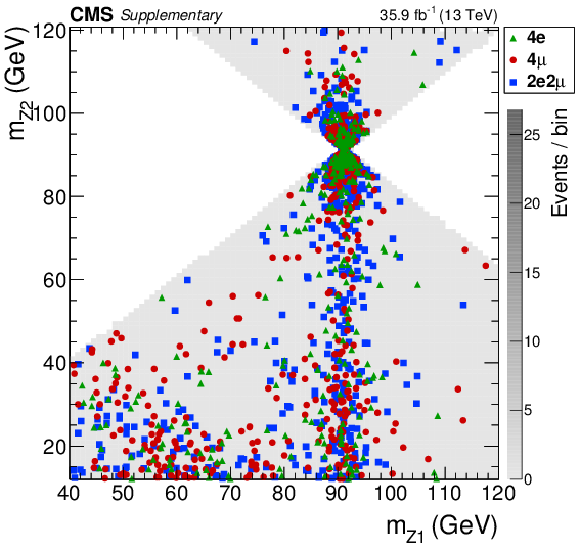
png pdf |
Additional Figure 4-c:
Correlation between the reconstructed invariant masses $ {\mathrm {Z}}_1$ and $ {\mathrm {Z}}_2$ in the region $m_{4\ell} > $ 70 GeV. The gray scale represents the expected total number of ZZ background and Higgs boson signal events for $m_{\rm H} = $ 125 GeV. |

png pdf |
Additional Figure 5:
(a) Distribution of ${\cal D}^{\rm kin}_{\rm bkg}$ in the region $m_{4\ell} > $ 70 GeV. The stacked histograms represent the expected signal and background distributions, and points represent the data. The SM Higgs boson signal with $m_{\rm {H}} = $ 125 GeV, denoted as ${\rm H}(125)$, and the ZZ backgrounds are normalized to the SM expectation and the Z+X background to the estimation from data. (b) 2D distribution of ${\cal D}^{\rm kin}_{\rm bkg}$ vs $m_{4\ell}$ in the region 170 $ < m_{4\ell} < $ 1000 GeV. The gray scale represents the expected total number of ZZ background and Higgs boson signal events for $m_{\rm H} = $ 125 GeV. The points show the data and the horizontal bars represent the measured event-by-event mass uncertainties. |

png pdf |
Additional Figure 5-a:
Distribution of ${\cal D}^{\rm kin}_{\rm bkg}$ in the region $m_{4\ell} > $ 70 GeV. The stacked histograms represent the expected signal and background distributions, and points represent the data. The SM Higgs boson signal with $m_{\rm {H}} = $ 125 GeV, denoted as ${\rm H}(125)$, and the ZZ backgrounds are normalized to the SM expectation and the Z+X background to the estimation from data. |
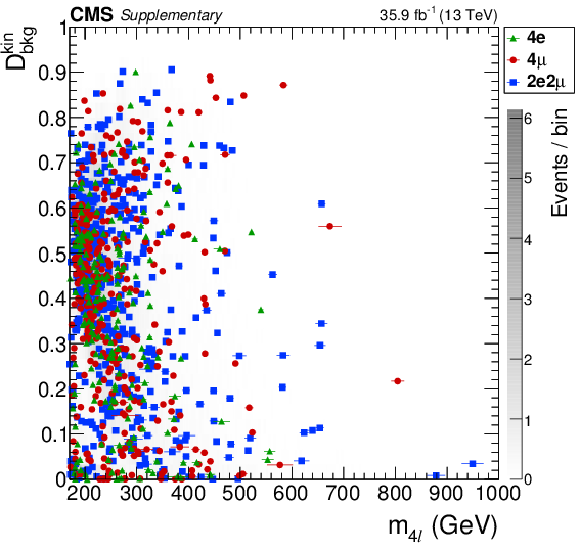
png pdf |
Additional Figure 5-b:
2D distribution of ${\cal D}^{\rm kin}_{\rm bkg}$ vs $m_{4\ell}$ in the region 170 $ < m_{4\ell} < $ 1000 GeV. The gray scale represents the expected total number of ZZ background and Higgs boson signal events for $m_{\rm H} = $ 125 GeV. The points show the data and the horizontal bars represent the measured event-by-event mass uncertainties. |
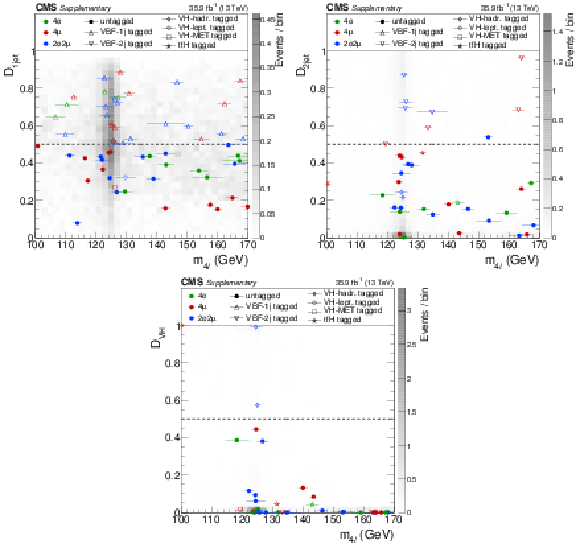
png pdf |
Additional Figure 6:
2D distributions of ${\mathcal D}_{\rm 1jet}$ (a), ${\mathcal D}_{\rm 2jet}$ (b), ${\mathcal D}_{\rm VH}$ (c) vs $m_{4\ell}$ in the region 100 $ < m_{4\ell} < $ 170 GeV. The gray scale represents the expected relative density of ZZ background plus Higgs boson signal for$m_{\rm H} = $ 125 GeV. The points show the data and the horizontal bars represent the measured event-by-event mass uncertainties. The gray dashed lines denote the working points used in the event categorization and different marker styles are used to denote the final categorization of the events. |
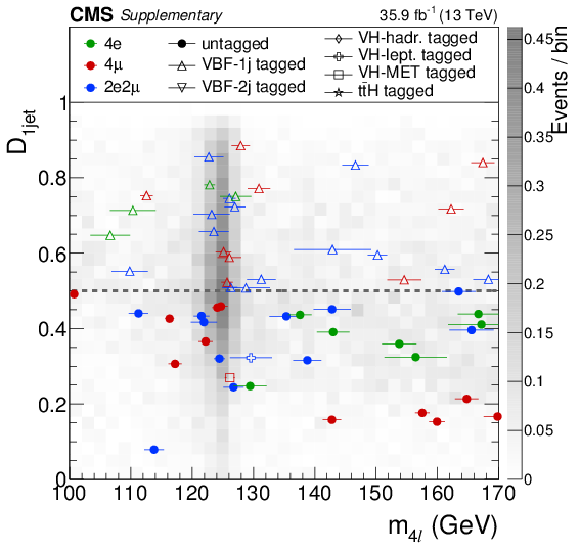
png pdf |
Additional Figure 6-a:
2D distribution of ${\mathcal D}_{\rm 1jet}$ vs $m_{4\ell}$ in the region 100 $ < m_{4\ell} < $ 170 GeV. The gray scale represents the expected relative density of ZZ background plus Higgs boson signal for$m_{\rm H} = $ 125 GeV. The points show the data and the horizontal bars represent the measured event-by-event mass uncertainties. The gray dashed lines denote the working points used in the event categorization and different marker styles are used to denote the final categorization of the events. |
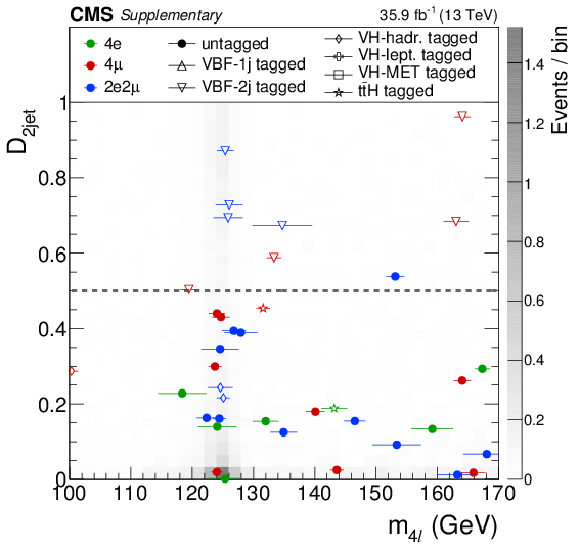
png pdf |
Additional Figure 6-b:
2D distribution of ${\mathcal D}_{\rm 2jet}$ vs $m_{4\ell}$ in the region 100 $ < m_{4\ell} < $ 170 GeV. The gray scale represents the expected relative density of ZZ background plus Higgs boson signal for$m_{\rm H} = $ 125 GeV. The points show the data and the horizontal bars represent the measured event-by-event mass uncertainties. The gray dashed lines denote the working points used in the event categorization and different marker styles are used to denote the final categorization of the events. |

png pdf |
Additional Figure 6-c:
2D distribution of ${\mathcal D}_{\rm VH}$ vs $m_{4\ell}$ in the region 100 $ < m_{4\ell} < $ 170 GeV. The gray scale represents the expected relative density of ZZ background plus Higgs boson signal for$m_{\rm H} = $ 125 GeV. The points show the data and the horizontal bars represent the measured event-by-event mass uncertainties. The gray dashed lines denote the working points used in the event categorization and different marker styles are used to denote the final categorization of the events. |

png pdf |
Additional Figure 7:
Comparison of measured mass resolution with the predicted dilepton mass resolution using the event-by-event mass uncertainty for $ {\mathrm {Z}}\to \ell \ell $ events in data. The dashed lines denote a $ \pm $20% region, used as the systematic uncertainty on the resolution. |

png pdf |
Additional Figure 8:
Comparison of the four-lepton mass for simulated Higgs boson events with $m_{\rm H} = $ 125 GeV in the 4$\mu $ final state with and without the kinematic refit using $m({\rm Z}_1)$ constraint. |
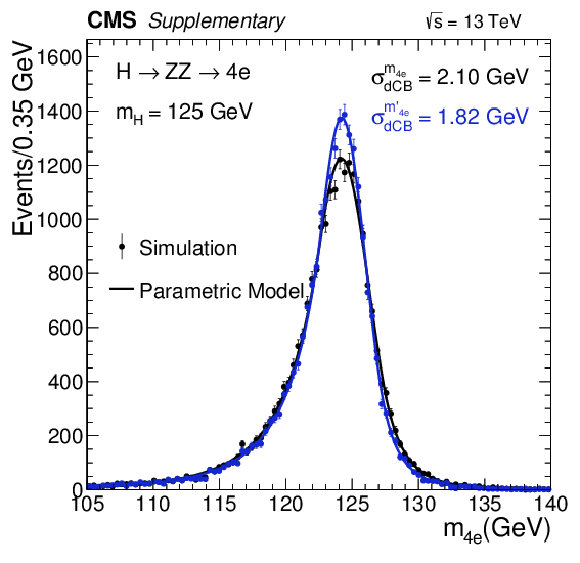
png pdf |
Additional Figure 9:
Comparison of the four-lepton mass for simulated Higgs boson events with $m_{\rm H} = $ 125 GeV in the 4e final state with and without the kinematic refit using $m({\rm Z}_1)$ constraint. |
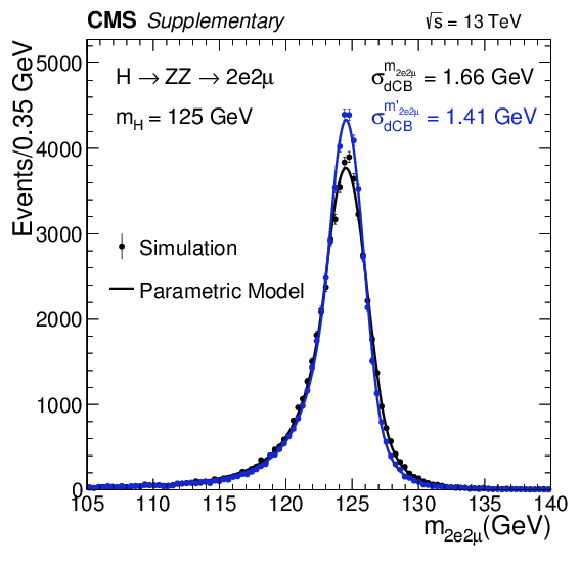
png pdf |
Additional Figure 10:
Comparison of the four-lepton mass for simulated Higgs boson events with $m_{\rm H} = $ 125 GeV in the 2e2$\mu $ final state with and without the kinematic refit using $m({\rm Z}_1)$ constraint. |
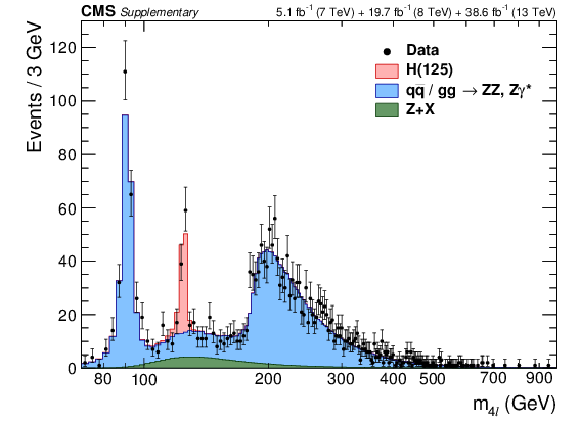
png pdf |
Additional Figure 11:
Four lepton mass distribution using the full CMS datasets from $\sqrt {s}= $ 7, 8 and 13 TeV. The stacked histograms represent the expected signal and background distributions, and points represent the data. The SM Higgs boson signal with $m_{\rm {H}} = $ 125 GeV, denoted as ${\rm H}(125)$, and the ZZ backgrounds are normalized to the SM expectation and the Z+X background to the estimation from data. |

png pdf |
Additional Figure 12:
Matrix showing the correlation between bins of the differential cross section measurements, for the Higgs transverse momentum. |
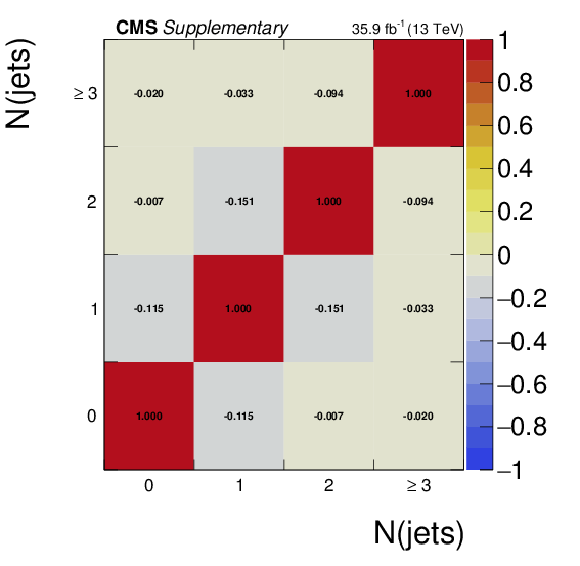
png pdf |
Additional Figure 13:
Matrix showing the correlation between bins of the differential cross section measurements, for the jet multiplicity. |
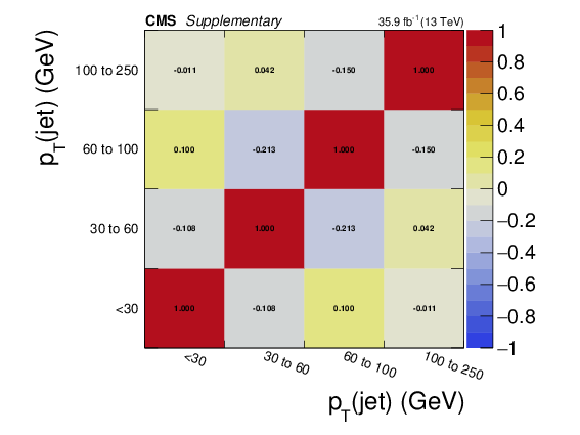
png pdf |
Additional Figure 14:
Matrix showing the correlation between bins of the differential cross section measurements, for the transverse momentum of the leading jet. |
| References | ||||
| 1 | ATLAS Collaboration | Observation of a new particle in the search for the Standard Model Higgs boson with the ATLAS detector at the LHC | PLB 716 (2012) 1 | 1207.7214 |
| 2 | CMS Collaboration | Observation of a new boson at a mass of 125 GeV with the CMS experiment at the LHC | PLB 716 (2012) 30 | CMS-HIG-12-028 1207.7235 |
| 3 | CMS Collaboration | Observation of a new boson with mass near 125 GeV in pp collisions at $ \sqrt{s} = $ 7 and 8 TeV | JHEP 06 (2013) 081 | CMS-HIG-12-036 1303.4571 |
| 4 | CMS Collaboration | Precise determination of the mass of the Higgs boson and tests of compatibility of its couplings with the standard model predictions using proton collisions at 7 and 8 TeV | EPJC 75 (2015) 212 | CMS-HIG-14-009 1412.8662 |
| 5 | ATLAS Collaboration | Measurements of the Higgs boson production and decay rates and coupling strengths using $ pp $ collision data at $ \sqrt{s}= $ 7 and 8 TeV in the ATLAS experiment | EPJC 76 (2016) 6 | 1507.04548 |
| 6 | ATLAS and CMS Collaborations | Measurements of the Higgs boson production and decay rates and constraints on its couplings from a combined ATLAS and CMS analysis of the LHC pp collision data at $ \sqrt{s}= $ 7 and 8 TeV | JHEP 08 (2016) 45 | 1606.02266 |
| 7 | F. Englert and R. Brout | Broken symmetry and the mass of gauge vector mesons | PRL 13 (1964) 321 | |
| 8 | P. W. Higgs | Broken symmetries, massless particles and gauge fields | PL12 (1964) 132 | |
| 9 | P. W. Higgs | Broken symmetries and the masses of gauge bosons | PRL 13 (1964) 508 | |
| 10 | G. S. Guralnik, C. R. Hagen, and T. W. B. Kibble | Global conservation laws and massless particles | PRL 13 (1964) 585 | |
| 11 | P. W. Higgs | Spontaneous symmetry breakdown without massless bosons | PR145 (1966) 1156 | |
| 12 | T. W. B. Kibble | Symmetry breaking in non-abelian gauge theories | PR155 (1967) 1554 | |
| 13 | ATLAS and CMS Collaborations | Combined measurement of the Higgs boson mass in $ pp $ collisions at $ \sqrt{s}= $ 7 and 8 TeV with the ATLAS and CMS experiments | PRL 114 (2015) 191803 | 1503.07589 |
| 14 | CMS Collaboration | Measurement of the properties of a Higgs boson in the four-lepton final state | PRD 89 (2014) 092007 | CMS-HIG-13-002 1312.5353 |
| 15 | CMS Collaboration | Study of the mass and spin-parity of the Higgs boson candidate via its decays to $ Z $ boson pairs | PRL 110 (2013) 081803 | CMS-HIG-12-041 1212.6639 |
| 16 | CMS Collaboration | Constraints on the spin-parity and anomalous HVV couplings of the Higgs boson in proton collisions at 7 and 8 TeV | PRD 92 (2015) 012004 | CMS-HIG-14-018 1411.3441 |
| 17 | ATLAS Collaboration | Measurements of Higgs boson production and couplings in the four-lepton channel in pp collisions at center-of-mass energies of 7 and 8 TeV with the ATLAS detector | PRD 91 (2015) 012006 | 1408.5191 |
| 18 | ATLAS Collaboration | Study of the spin and parity of the Higgs boson in diboson decays with the ATLAS detector | EPJC 75 (2015) 476 | 1506.05669 |
| 19 | CMS Collaboration | Constraints on the Higgs boson width from off-shell production and decay to Z-boson pairs | PLB 736 (2014) 64 | CMS-HIG-14-002 1405.3455 |
| 20 | CMS Collaboration | Limits on the Higgs boson lifetime and width from its decay to four charged leptons | PRD 92 (2015) 072010 | CMS-HIG-14-036 1507.06656 |
| 21 | ATLAS Collaboration | Constraints on the off-shell Higgs boson signal strength in the high-mass ZZ and WW final states with the ATLAS detector | EPJC 75 (2015) 335 | 1503.01060 |
| 22 | CMS Collaboration | Measurement of differential and integrated fiducial cross sections for Higgs boson production in the four-lepton decay channel in pp collisions at $ \sqrt{s} = $ 7 and 8 TeV | JHEP 04 (2016) 005 | CMS-HIG-14-028 1512.08377 |
| 23 | ATLAS Collaboration | Measurements of the total and differential Higgs boson production cross sections combining the $ H \to \gamma \gamma $ and $ H \to ZZ^{*}\to 4l $ decay channels at $ \sqrt{s}= $ 8 TeV with the ATLAS detector | PRL 115 (2015) 091801 | 1504.05833 |
| 24 | CMS Collaboration | The CMS experiment at the CERN LHC | JINST 3 (2008) S08004 | CMS-00-001 |
| 25 | CMS Collaboration | Description and performance of track and primary-vertex reconstruction with the CMS tracker | JINST 9 (2014) P10009 | CMS-TRK-11-001 1405.6569 |
| 26 | CMS Collaboration | Performance of electron reconstruction and selection with the CMS detector in proton-proton collisions at $ \sqrt{s} = $ 8 TeV | JINST 10 (2015) P06005 | CMS-EGM-13-001 1502.02701 |
| 27 | CMS Collaboration | Performance of CMS muon reconstruction in pp collision events at $ \sqrt{s} = $ 7 TeV | JINST 7 (2012) P10002 | CMS-MUO-10-004 1206.4071 |
| 28 | CMS Collaboration | The cms trigger system | JINST 12 (2017) P01020 | CMS-TRG-12-001 1609.02366 |
| 29 | CMS Collaboration | Measurement of the inclusive $ W $ and $ Z $ production cross sections in $ pp $ collisions at $ \sqrt{s}= $ 7 TeV | JHEP 10 (2011) 132 | CMS-EWK-10-005 1107.4789 |
| 30 | S. Alioli, P. Nason, C. Oleari, and E. Re | NLO vector-boson production matched with shower in POWHEG | JHEP 07 (2008) 060 | 0805.4802 |
| 31 | P. Nason | A new method for combining NLO QCD with shower Monte Carlo algorithms | JHEP 11 (2004) 040 | hep-ph/0409146 |
| 32 | S. Frixione, P. Nason, and C. Oleari | Matching NLO QCD computations with parton shower simulations: the POWHEG method | JHEP 11 (2007) 070 | 0709.2092 |
| 33 | G. Luisoni, P. Nason, C. Oleari, and F. Tramontano | HW$ ^{\pm} $/HZ + 0 and 1 jet at NLO with the POWHEG BOX interfaced to GoSam and their merging within MiNLO | JHEP 10 (2013) 1 | 1306.2542 |
| 34 | LHC Higgs Cross Section Working Group | Handbook of LHC Higgs Cross Sections: 4. Deciphering the Nature of the Higgs Sector | (CERN, Geneva, 2016) | 1610.07922 |
| 35 | C. Anastasiou et al. | High precision determination of the gluon fusion Higgs boson cross-section at the LHC | JHEP 05 (2016) 058 | 1602.00695 |
| 36 | R. D. Ball et al. | Unbiased global determination of parton distributions and their uncertainties at NNLO and at LO | Nucl. Phys. B 855 (2012) 153 | 1107.2652 |
| 37 | Y. Gao et al. | Spin determination of single-produced resonances at hadron colliders | PRD 81 (2010) 075022 | 1001.3396 |
| 38 | S. Bolognesi et al. | On the spin and parity of a single-produced resonance at the LHC | PRD 86 (2012) 095031 | 1208.4018 |
| 39 | D. de Florian, G. Ferrera, M. Grazzini, and D. Tommasini | Higgs boson production at the LHC: transverse momentum resummation effects in the $ H \to \gamma \gamma $, $ H \to WW \to \ell\nu\ell\nu $ and $ H \to ZZ \to 4\ell $ decay modes | JHEP 06 (2012) 132 | 1203.6321 |
| 40 | M. Grazzini and H. Sargsyan | Heavy-quark mass effects in Higgs boson production at the LHC | JHEP 09 (2013) 129 | 1306.4581 |
| 41 | J. M. Campbell and R. K. Ellis | MCFM for the Tevatron and the LHC | NPPS 205 (2010) 10 | 1007.3492 |
| 42 | T. Sjostrand et al. | An introduction to PYTHIA 8.2 | CPC 191 (2015) 159 | 1410.3012 |
| 43 | CMS Collaboration | Event generator tunes obtained from underlying event and multiparton scattering measurements | EPJC 76 (2016) 155 | CMS-GEN-14-001 1512.00815 |
| 44 | GEANT4 Collaboration | GEANT4---a simulation toolkit | NIMA 506 (2003) 250 | |
| 45 | J. Allison et al. | Geant4 developments and applications | IEEE Trans. Nucl. Sci. 53 (2006) 270 | |
| 46 | CMS Collaboration | Particle-flow reconstruction and global event description with the CMS detector | Submitted to JINST | CMS-PRF-14-001 1706.04965 |
| 47 | M. Cacciari, G. P. Salam, and G. Soyez | The anti-$ k_t $ jet clustering algorithm | JHEP 04 (2008) 063 | 0802.1189 |
| 48 | M. Cacciari, G. P. Salam, and G. Soyez | FastJet user manual | EPJC 72 (2012) 1896 | 1111.6097 |
| 49 | M. Cacciari and G. P. Salam | Pileup subtraction using jet areas | PLB 659 (2008) 119 | 0707.1378 |
| 50 | M. Cacciari, G. P. Salam, and G. Soyez | The catchment area of jets | JHEP 04 (2008) 005 | 0802.1188 |
| 51 | CMS Collaboration | Performance of photon reconstruction and identification with the CMS detector in proton-proton collisions at $ \sqrt{s} = $ 8 TeV | JINST 10 (2015) P08010 | CMS-EGM-14-001 1502.02702 |
| 52 | R. Fruhwirth | Application of Kalman filtering to track and vertex fitting | NIMA 262 (1987) 444 | |
| 53 | CMS Collaboration | Determination of jet energy calibration and transverse momentum resolution in CMS | JINST 6 (2011) P11002 | CMS-JME-10-011 1107.4277 |
| 54 | CMS Collaboration | Jet energy scale and resolution in the CMS experiment in pp collisions at 8 TeV | JINST 12 (2017) P02014 | CMS-JME-13-004 1607.03663 |
| 55 | CMS Collaboration | Identification of b-quark jets with the CMS experiment | JINST 8 (2013) P04013 | CMS-BTV-12-001 1211.4462 |
| 56 | CMS Collaboration | Identification of b quark jets at the CMS Experiment in the LHC Run 2 | CMS-PAS-BTV-15-001 | CMS-PAS-BTV-15-001 |
| 57 | ALEPH, DELPHI, L3, OPAL, SLD Collaborations, LEP Electroweak Working Group, and SLD Electroweak and Heavy Flavour Groups | Precision electroweak measurements on the Z resonance | Phys. Rep. 427 (2006) 257 | |
| 58 | I. Anderson et al. | Constraining anomalous $ HVV $ interactions at proton and lepton colliders | PRD 89 (2014) 035007 | 1309.4819 |
| 59 | M. J. Oreglia | A study of the reactions $\psi' \to \gamma\gamma \psi$ | PhD thesis, Stanford University, 1980 SLAC Report SLAC-R-236, see Appendix D | |
| 60 | M. Grazzini, S. Kallweit, and D. Rathlev | ZZ production at the LHC: Fiducial cross sections and distributions in NNLO QCD | PLB 750 (2015) 407 | 1507.06257 |
| 61 | A. Bierweiler, T. Kasprzik, and J. H. Kuhn | Vector-boson pair production at the LHC to $ {\cal O}(\alpha^3) $ accuracy | JHEP 12 (2013) 071 | 1305.5402 |
| 62 | M. Bonvini et al. | Signal-background interference effects in $ gg \to H \to WW $ beyond leading order | PRD 88 (2013) 034032 | 1304.3053 |
| 63 | K. Melnikov and M. Dowling | Production of two Z-bosons in gluon fusion in the heavy top quark approximation | PLB 744 (2015) 43 | 1503.01274 |
| 64 | C. S. Li, H. T. Li, D. Y. Shao, and J. Wang | Soft gluon resummation in the signal-background interference process of $ gg(\to h^*) \to ZZ $~ | JHEP 08 (2015) 065 | 1504.02388 |
| 65 | G. Passarino | Higgs CAT | EPJC 74 (2014) 2866 | 1312.2397 |
| 66 | S. Catani and M. Grazzini | Next-to-Next-to-Leading-Order subtraction formalism in hadron collisions and its application to Higgs-boson production at the Large Hadron Collider | PRL 98 (2007) 222002 | hep-ph/0703012 |
| 67 | M. Grazzini | NNLO predictions for the Higgs boson signal in the H $ \to WW \to\ell\nu\ell\nu $ and H$ \to ZZ \to4\ell $ decay channels | JHEP 02 (2008) 043 | 0801.3232 |
| 68 | L. Landau | On the energy loss of fast particles by ionization | J. Phys. (USSR) 8 (1944)201 | |
| 69 | CMS Collaboration | CMS luminosity measurements for the 2016 data taking period | CMS-PAS-LUM-17-001 | CMS-PAS-LUM-17-001 |
| 70 | J. Butterworth et al. | PDF4LHC recommendations for LHC Run II | JPG 43 (2016) 023001 | 1510.03865 |
| 71 | F. Garwood | Fiducial limits for the poisson distribution | Biometrika 28 (1936), no. 3-4, 437 | |
| 72 | ATLAS and CMS Collaborations, LHC Higgs Combination Group | Procedure for the LHC Higgs boson search combination in Summer 2011 | ATL-PHYS-PUB/CMS NOTE 2011-11, 2011/005, CERN | |
| 73 | T. Junk | Confidence level computation for combining searches with small statistics | NIMA 434 (1999) 435 | hep-ex/9902006 |
| 74 | A. L. Read | Modified frequentist analysis of search results (the $ {CL}_s $ method) | in Proceedings of the Workshop on confidence limits, CERN-OPEN-2000-005 | |
| 75 | G. Cowan, K. Cranmer, E. Gross, and O. Vitells | Asymptotic formulae for likelihood-based tests of new physics | EPJC 71 (2011) 1554 | 1007.1727 |
| 76 | CMS Collaboration | Measurement of differential cross sections for Higgs boson production in the diphoton decay channel in pp collisions at $ \sqrt{s} = $ 8 TeV | EPJC 76 (2015) 13 | |
| 77 | K. Hamilton, P. Nason, E. Re, and G. Zanderighi | NNLOPS simulation of Higgs boson production | JHEP 10 (2013) 222 | 1309.0017 |

|
Compact Muon Solenoid LHC, CERN |

|

|

|

|

|

|